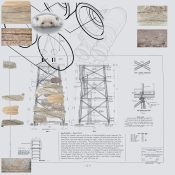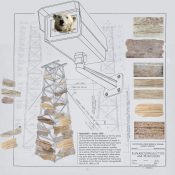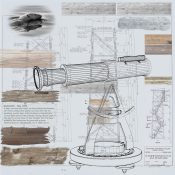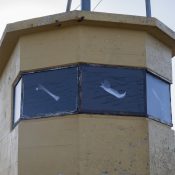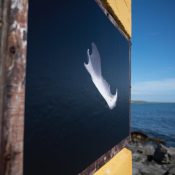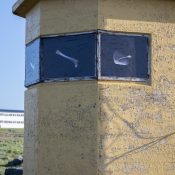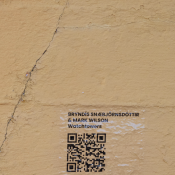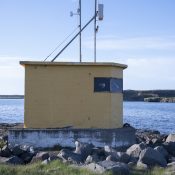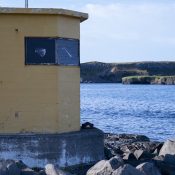- Raufarhöfn June 1914
- Raufarhöfn March 1965
- Raufarhöfn May 1969
- Raufarhöfn Watchtower 2024
- Raufarhöfn Watchtower 2024
- Raufarhöfn Watchtower 2024
- QR code (on site) SCAN
- Raufarhöfn Watchtower 2024
- Raufarhöfn Watchtower 2024
Watchtowers (Raufarhöfn) 2024
(site photos by Julie Sjöfn Gasiglia)
The duo Bryndís Snæbjörnsdóttir and Mark Wilson installed two related works in the group exhibition Túndran og tifið á Sléttu, in Óskarsbraggi and around Raufarhöfn, Iceland, during the summer of 2024. (See virtual exhibition link below). One installation involved the old lighthouse situated between the town lake and the seashore – and the other, inside the Óskarsbraggi building, comprising three proposals for watchtowers. Each of theproposals is related to a particular historical event in which polar bears came to the shores of Raufarhöfn. The watchtowers are intended both as memorials to the bears involved and as prospective viewing platforms to enable early sightings of approaching animals from the sea. This idea signals an imagined shift in the way we humans might regard animals with whom we share the environment and reflects modest allowances and investment in the welfare of animal others,already in place around the world. Polar bears have come to Iceland for many millennia before the arrival of humans, and in this shift, future arrivals might be planned for and handled by people in generally a more imaginative and sympathetic manner.
At the lighthouse, the windows have been blanked with images of bones salvaged from one, the female, of two polar bears that arrived in the north of Iceland in June 2008. A three-times mother of 16 years, to get here she had swum over 300 km from Greenland. Although some strategies for her capture and release were considered, in the end, though she was fatigued, she got up from where she had lain for many hours on the shore, and on moving back in the direction of the sea, was shot dead. In one of the Raufarhöfn reports, from 1969, an already dead polar bear was washed ashore here. In another, from 1914, a bear was tracked down and shot and in a third, in 1965, bears were heard bellowing through the dense mist, far out on the sea ice.
https://oskarsbraggi.com/TUNDRAN-OG-TIFID-A-SLETTU-VIRTUAL
Raufarhöfn – June 1914
After the summer, sea ice drifted up to Melrakkaslétta and Langanes. On Monday in the second week of summer, people in Raufarhöfn noticed that a polar bear had come ashore during the night close to the houses and the trail lay southwest to the heath. The brothers Níels and Maríus Lund then prepared to leave home with guns and followed the trail. They found the bear, playing with the carcass of a bird it had found, rolling on its back and throwing the bird in the air in all directions, like a kitten playing with a balloon. When the bear noticed them, it stopped the game and ambled in front of them, until stopping at a rock on a hill. Climbing up, it looked around. At that moment, Níels shot at it. The ball hit the bear in the shoulder and it bowed down, still alive. They fired another shot – and then, it was enough. Heimild/Source: Ingólfur 7. júní 1914, bls. 86
Raufarhöfn – March 1965
There had been considerable ice for the whole of the North in the second half of March. Stories describe the displeasure of people in Raufarhöfn, on believing they hear polar bears out on the ice. The only evidence of their presence is this scream. However, another source states that the sailors thought it might be a walrus. Whether it was the cries of polar bears or walruses, it was people’s ideas about the polar bear that caused their dismay and anxiety. It was later revealed that there were two bears out on the ice. Source: Morgunblaðið, March 26, 1965, p. 28
Raufarhöfn – May 1969
A bear carcass was found: Ice had choked the harbour for three consecutive weeks, but now with ice receding, a polar bear drifted ashore in Raufarhöfn. It was dead and terribly bloated. It had clearly been in the sea for a long time. It was thought that the bear probably died sometime the previous autumn. Heimild/Source: Alþýðublaðið, 21. 5. 1969, bls. 5
